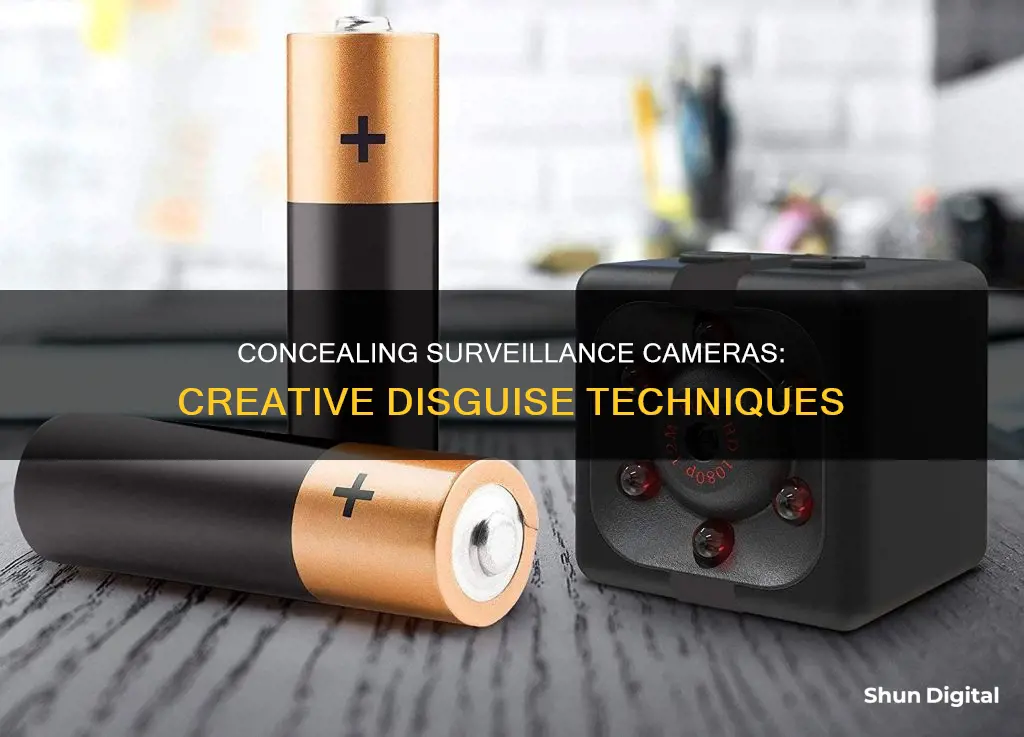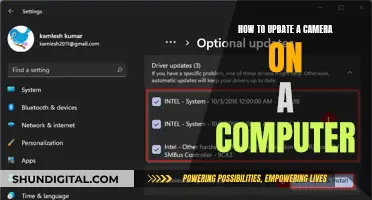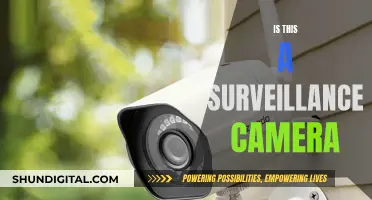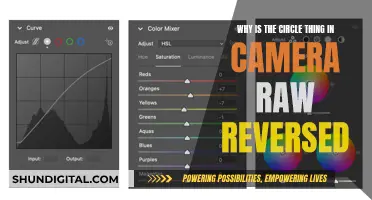
Keeping your home safe is a top priority, and security cameras are a great way to do this. However, sometimes it's best to hide them to prevent thieves from tampering with them. There are many ways to disguise security cameras, from hiding them in everyday objects like books, toys, and potted plants, to placing them in high-up, subtle locations like curtain rods, bookshelves, or ceilings. You can also use natural camouflage, such as trees and bushes, or conceal them in birdhouses. For indoor cameras, it's best to place them in well-lit areas with a wide-angle view, such as the living room or kitchen. Hiding cameras in plain sight can be an effective way to keep your home and family safe without sacrificing aesthetics or making your guests feel uncomfortable.
Characteristics of Surveillance Camera Set-up
| Characteristics | Values |
|---|---|
| Placement | Inside: living room, kitchen, toy room, or nursery. Outside: near the front door, in the birdhouse, or behind glass windows. |
| Lighting | Sufficient lighting is required for clear footage. |
| Angle | Positioned to capture wide angles for fuller surveillance coverage. |
| Height | 8 to 10 feet from the ground is recommended. |
| Disguise | Disguised as everyday objects such as artificial plants, tissue boxes, books, birdhouses, or toys. |
| Surveillance Coverage | Cameras should be placed in areas where burglars are most likely to enter, such as the front door, first-floor window, back door, or garage. |
| Legality | Ensure compliance with local laws and regulations regarding video surveillance and privacy. |
What You'll Learn
- Disguise cameras as everyday objects, e.g. toys, clocks, tissue boxes, books
- Place cameras in high locations, e.g. tops of bookshelves, cabinets, ceiling fans
- Use a doorbell camera to monitor front doors
- Position cameras at a height of 8-9 feet to capture clear footage
- Hide cameras in natural surroundings, e.g. trees, bushes, birdhouses

Disguise cameras as everyday objects, e.g. toys, clocks, tissue boxes, books
Disguising a security camera as an everyday object is a brilliant way to monitor your home without drawing attention. Here are some ideas for objects you can use to disguise your security camera:
Toys
If you want to keep an eye on your children or babysitters, hiding a security camera inside a stuffed toy is a great option. The toy will need to be large enough to accommodate the camera, and it's important to ensure that the camera lens is not obstructed. You could also place the camera in between several toys on a shelf, where it will be less noticeable.
Clocks
A clock is another everyday object that can be used to disguise a security camera. Typically placed on a wall or shelf, a clock camera can easily monitor a room without raising suspicion. Just make sure the clock is large enough to accommodate the camera, and that the camera lens is positioned correctly.
Tissue Boxes
A tissue box is an ideal disguise for a security camera as it can be easily placed on a counter or shelf. Simply cut a small hole in the side of the box for the camera lens, and you're good to go.
Books
A hollow book is a clever way to disguise a security camera, especially when placed on a bookshelf or mantle among other books. Just be sure to choose a book that is large enough to accommodate the camera and won't look out of place.
Other Options
Other everyday objects that can be used to disguise security cameras include smoke detectors, picture frames, decorative plants, and lanterns. You can also hide cameras behind curtains or curtains rods, where they are less likely to be noticed.
Remember to always be mindful of people's privacy when placing hidden cameras, and avoid areas where privacy is expected, such as bathrooms and bedrooms.
Troubleshooting Camera Raw Command Issues
You may want to see also

Place cameras in high locations, e.g. tops of bookshelves, cabinets, ceiling fans
Placing cameras in high locations is a great way to conceal them in plain sight. Here are some tips to help you make the most of this strategy:
Bookshelves
Bookshelves are an excellent spot for hiding security cameras because they blend in with their surroundings, camouflaged by books and other everyday items. Place the camera on the top of the bookshelf or bury it within one of the shelves. This high placement allows for a full view of the scene in front of it. Before settling on a location, test the camera to ensure it can capture all important areas clearly and without interference from objects in the room.
Cabinets
Display cabinets, such as kitchen hutches or china cabinets, are another effective option for concealing cameras. These pieces of furniture tend to be tall and display various items, allowing security cameras to blend in seamlessly. Place the camera on top of the cabinet or within one of the shelves to discreetly capture footage of activities near entrances or patio doors.
Ceiling Fans
Ceiling fans are an often-overlooked location for hiding security cameras. Their height makes them an ideal spot to capture a wide area without attracting attention. Burglars are less likely to look up when entering your home, so this high vantage point can provide a clear and unobstructed view. Test the camera to ensure it has a good angle and that its view isn't blocked by the fan blades.
Art Hung High on the Wall
Artwork hung high on walls can also be used to conceal cameras. Choose a piece of art with a sturdy frame or built-in compartments that can accommodate a camera. Ensure that the artwork is hung at a height that allows the camera to capture the desired area without obstructions. Keep in mind that you should test the camera before final installation to ensure optimal placement.
By leveraging these high locations, you can effectively hide your security cameras in plain sight, providing both discretion and comprehensive surveillance coverage.
Focusing Your Camera: Kindle Fire Tips and Tricks
You may want to see also

Use a doorbell camera to monitor front doors
Doorbell cameras are an excellent way to monitor your front door without worrying about hiding the camera. It is also at the perfect height to capture a full-body view of visitors. While intruders may be looking for other hidden cameras near your entryway, they might not notice the doorbell camera.
- Choose a suitable doorbell camera: There are various doorbell cameras available on the market, such as the Google Nest Doorbell, Ring Video Doorbell, and Eufy Security Video Doorbell. Consider factors like video quality, audio capabilities, motion detection, and cloud storage when selecting a doorbell camera.
- Install the doorbell camera at the right height: The recommended height for outdoor cameras is between 8 and 9 feet from the ground. Installing the camera lower than 8 feet makes it easily reachable and susceptible to tampering or destruction. On the other hand, mounting it higher than 9 feet may result in grainy or incomplete footage.
- Utilize the features of the doorbell camera: Most modern doorbell cameras offer features like motion detection, two-way audio, and cloud storage. Take advantage of these features to enhance your front door security. For example, you can set up motion detection alerts to notify you when someone approaches your door, or use the two-way audio feature to communicate with visitors remotely.
- Consider adding a smart lock: Integrating a smart lock with your doorbell camera allows you to unlock the door remotely using your smartphone. This can be especially useful when expecting deliveries or granting access to trusted individuals when you're not home.
- Be mindful of legal considerations: Before installing a doorbell camera, familiarize yourself with your state's laws regarding unauthorized video surveillance. In most cases, you must obtain consent from individuals being recorded. Additionally, avoid placing the camera in areas where it may inadvertently capture footage of someone in a private setting, such as a bathroom or changing area.
By following these tips, you can effectively use a doorbell camera to monitor your front door while also maintaining the security and privacy of your home.
Understanding Camera's Selective Focus: Creative Photography Technique
You may want to see also

Position cameras at a height of 8-9 feet to capture clear footage
Positioning security cameras at the right height is crucial for capturing clear footage and ensuring your property is adequately surveilled. While you may be tempted to place cameras high up to avoid detection, mounting them too high will compromise video quality and render them ineffective at night.
The optimal height for installing security cameras is generally considered to be around 8 feet (2.5m) off the ground. This height strikes a balance between safety and security, protecting the cameras from vandals while providing adequate field coverage. At this height, the camera's infrared illumination can effectively monitor its surroundings, and the lens can capture clear footage without distortion.
However, if you're aiming to capture a wider field of view and benefit from a longer focal length, mounting the camera at a height of 9 feet (2.7m) or slightly higher can be beneficial. This increased height allows the camera to see as far away as possible, capturing a more expansive view of the surroundings.
For outdoor cameras, it's important to note that anything higher than 9 feet may result in grainy or incomplete footage, and anything lower than 8 feet leaves the camera vulnerable to tampering or destruction.
To ensure clear footage, test the camera's position before finalizing its location. Confirm that it can capture all important areas clearly and without interference from nearby objects. Additionally, consider the lighting conditions, as direct sunlight or reflections can affect video quality.
By following these guidelines and positioning your cameras at the recommended height, you can maximize the effectiveness of your surveillance system and help ensure the safety of your home or business.
Understanding Your Camera's DPI and RAW Settings
You may want to see also

Hide cameras in natural surroundings, e.g. trees, bushes, birdhouses
Hiding security cameras in natural surroundings, such as trees, bushes, and birdhouses, is a clever way to enhance the security of your home discreetly. Here are some detailed instructions to help you achieve this:
Trees and Bushes:
- Choose a small security camera that can be easily concealed. A mini or spy camera is ideal as they are compact and often wireless, making them more flexible for placement.
- Consider painting the camera to blend in with the surroundings. For example, if hiding the camera in a bush, you may want to paint it green. However, be cautious as painting may void the camera's warranty.
- Strategically place the camera so that it is hidden behind the foliage of the tree or bush. Ensure the camera body is concealed, but the lens is not obstructed by branches or leaves.
- If using a wired camera, carefully hide the wires by running them through a PVC pipe or burying them underground. Alternatively, consider using a wireless camera to avoid this issue.
- Ensure the camera is positioned to capture a wide-angle view without obstructions.
Birdhouses:
- Select a birdhouse that is large enough to accommodate the camera. Modern security cameras, especially mini cameras, are often compact enough to fit inside.
- Choose a birdhouse design that allows for easy access to the camera for maintenance and adjustments.
- Position the camera so that it does not obstruct the entrance or exit of the birdhouse, allowing birds to use it freely.
- Ensure the camera is angled to capture the desired field of view without being too noticeable.
- Consider the weather conditions and position the camera to avoid direct exposure to harsh weather, protecting its functionality.
- If using a wired camera, try to conceal the wires within the birdhouse or run them along the tree or post supporting the birdhouse.
Hiding security cameras in natural surroundings is an effective way to monitor your property without drawing attention. By following these instructions, you can enhance the security of your home while maintaining its aesthetic appeal.
Understanding Servo Mode in Camera: Focusing on Autofocus Precision
You may want to see also
Frequently asked questions
Hidden cameras are less likely to be spotted and disabled by intruders. They can also be used to monitor activity without guests feeling uncomfortable, and they won't detract from the aesthetics of your home.
Cameras can be hidden in everyday household items such as toys, books, tissue boxes, potted plants, or small electronic gadgets. High places like the tops of bookshelves, cabinets, or ceiling fans are also good spots, as burglars are less likely to look up.
Outdoor cameras can be disguised in birdhouses, or placed near trees or bushes to camouflage them. They can also be hidden behind glass windows or placed inside a mailbox.
Yes, it is generally advised to speak to an attorney about the specific ways you plan to use the camera and the locations you'd like it to be installed. Do not place cameras in areas where people have a reasonable expectation of privacy, such as bathrooms.







